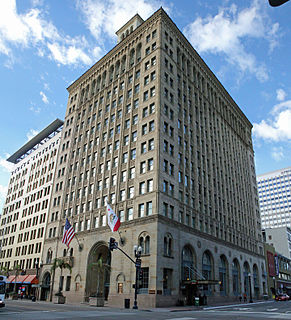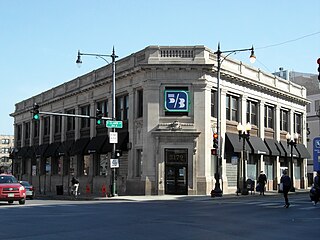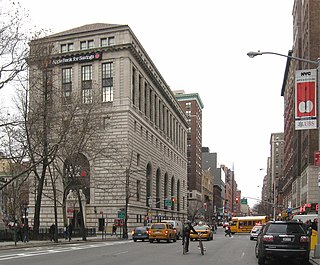
Rene Paul Chambellan was an American sculptor who specialized in architectural sculpture. He was also one of the foremost practitioners of what was then called the "French Modern Style" and has subsequently been labeled Zig-Zag Moderne, or Art Deco. He also frequently designed in the Greco Deco style.

Austin is one of 77 community areas in Chicago Located on the city's West Side, it is the third largest community area by population and the second-largest geographically. Austin's eastern boundary is the Belt Railway located just east of Cicero Avenue. Its northernmost border is the Milwaukee District / West Line. Its southernmost border is at Roosevelt Road from the Belt Railway west to Austin Boulevard. The northernmost portion, north of North Avenue, extends west to Harlem Avenue, abutting Elmwood Park. In addition to Elmwood Park, Austin also borders the suburbs of Cicero and Oak Park.

The National Bank of Detroit (NBD), later renamed NBD Bank, was a bank that operated mostly in the Midwestern United States. Following its merger with First National Bank of Chicago, the bank was ultimately acquired and merged into Bank One, at which point the NBD name was discontinued. Today, what was once NBD is owned by JPMorgan Chase & Co.

The Belmont–Sheffield Trust and Savings Bank Building is a six-story building built in 1928 at 1001 W. Belmont Avenue, Chicago, Illinois. The building was designed by architect John Nyden and is on the National Register of Historic Places. It was constructed in a U-shape around a two-story central atrium, which allowed light to reach the bank lobby—the glass atrium has since been roofed over.

Graham, Anderson, Probst & White (GAP&W) was a Chicago architectural firm that was founded in 1912 as Graham, Burnham & Co. This firm was the successor to D. H. Burnham & Co. through Daniel Burnham's surviving partner, Ernest R. Graham, and Burnham's sons, Hubert Burnham and Daniel Burnham Jr. In 1917, the Burnhams left to form their own practice, which eventually became Burnham Brothers, and Graham and the remaining members of Graham, Burnham & Co. – Graham, (William) Peirce Anderson, Edward Mathias Probst, and Howard Judson White – formed the resulting practice. The firm also employed Victor Andre Matteson.
Marshall and Fox was a United States architectural firm based in Chicago from 1905 to 1926. The principals, Benjamin H. Marshall and Charles E. Fox, designed a number of significant buildings of many types in Chicago and other cities, but they were best known for luxury hotels and apartment buildings.
Sovran Bank was a US-based regional bank that operated in Virginia between 1983 and 1990, and was the leading subsidiary of Sovran Financial Corporation. It was itself a product of a merger between First & Merchants Bank of Richmond and Virginia National Bankshares of Norfolk, both of which could trace back their history to the 1860s. In 1990, it was merged with Citizens & Southern National Bank to form C&S/Sovran Corp., which in turn merged with NCNB to form NationsBank which became Bank of America in 1998.
Sidney Lovell was an American architect best known for designing mausoleums, and to a lesser extent theaters and opera houses. His first cemetery commission, the mausoleum at Rosehill Cemetery in Chicago, Illinois, is considered his best work. He obtained a patent on an improved mausoleum ventilation system in 1917. Two of his works are listed on the National Register of Historic Places.

Davenport Bank and Trust Company was for much of the 20th century the leading bank of the Quad Cities metropolitan area and the surrounding region of eastern Iowa and western Illinois. It was at one time Iowa's largest commercial bank, and the headquarters building has dominated the city's skyline since it was constructed in 1927 at the corner of Third and Main Streets in downtown Davenport, Iowa. It was acquired by Norwest Bank of Minneapolis in 1993 and now operates as part of Wells Fargo following a 1998 merger of the two financial institutions. The historic building was listed on the National Register of Historic Places in 1983 under the name of its predecessor financial institution American Commercial and Savings Bank. In 2016 the National Register approved a boundary increase with the Davenport Bank and Trust name. It was included as a contributing property in the Davenport Downtown Commercial Historic District in 2020. It remains the tallest building in the Quad Cities, and is today known as Davenport Bank Apartments as it has been redeveloped into a mixed-use facility housing commercial, office and residential space.

Farmers and Merchants Savings Bank, also known as Union Savings Bank and First Trust and Savings Bank, is an historic building located in Grand Mound, Iowa, United States. It was listed on the National Register of Historic Places in 2001.

The architecture of Jacksonville is a combination of historic and modern styles reflecting the city's early position as a regional center of business. According to the National Trust for Historic Preservation, there are more buildings built before 1967 in Jacksonville than any other city in Florida, but it is also important to note that few structures in the city center predate the Great Fire of 1901. Numerous buildings in the city have held state height records, dating as far back as 1902, and last holding a record in 1981.

Laura Street is a north–south street in Jacksonville, Florida, United States, named for the daughter of the city's founder, Isaiah D. Hart. Historically, the downtown portion of Laura Street has been considered the financial district of Jacksonville.

The San Diego Trust and Savings Bank Building is an historic building in San Diego, in the U.S. state of California. It was listed on the National Register of Historic Places in 1999.

The Medical Arts Building is an Art Deco office building at 715 Lake Street, Oak Park, Illinois. It is a contributing property to the Ridgeland–Oak Park Historic District. At 122 feet, it was the tallest building in Oak Park for several decades after it was built.

The Berwyn State Bank Building is an Art Deco office building at 6804 Windsor Avenue, Berwyn, Illinois. It was designed by Charles O. Liska and was built at a cost of $400,000 in 1929. It is a Berwyn Historic Landmark.

The Century Building is a high rise office building in Chicago's Loop. It was designed by Holabird & Roche, and was built in 1915. It is a contributing property to the Loop Retail Historic District. The building is representative of the transition of Chicago high rise design from the Chicago School to Art Deco, and its north and east facades feature Neo-Manueline ornamentation. It is owned by the General Services Administration and currently sits vacant.

The Lake View State Bank Building was a bank building at 3179 N. Clark Street, Chicago, Illinois. It was designed by Ivar Viehe-Naess and was built at a cost of $125,000 in 1920. It replaced Lake View State Bank's previous building which was a half-block south and was built five years earlier. The building was demolished in August 2021.

The Apple Bank Building, also known as the Central Savings Bank Building and 2100 Broadway, is a bank building and residential condominium at 2100–2114 Broadway on the Upper West Side of Manhattan in New York City. Constructed as a branch of the Central Savings Bank from 1926 to 1928, it occupies a trapezoidal city block bounded by 73rd Street to the south, Amsterdam Avenue to the east, 74th Street to the north, and Broadway to the west. The Apple Bank Building was designed by York and Sawyer in the Renaissance Revival and palazzo styles, patterned after an Italian Renaissance-style palazzo.

The Monterey County Trust & Savings Building, also known as China Art Center, is a historic Spanish Mission Revival commercial building in Carmel-by-the-Sea, California. It was designed by architects H. H. Winner Co., of San Francisco and built in 1929–1930, by Hugh W. Comstock and Michael J. Murphy. It was designated as an important commercial building in the city's Downtown Historic District Property Survey on October 18, 2002.
















